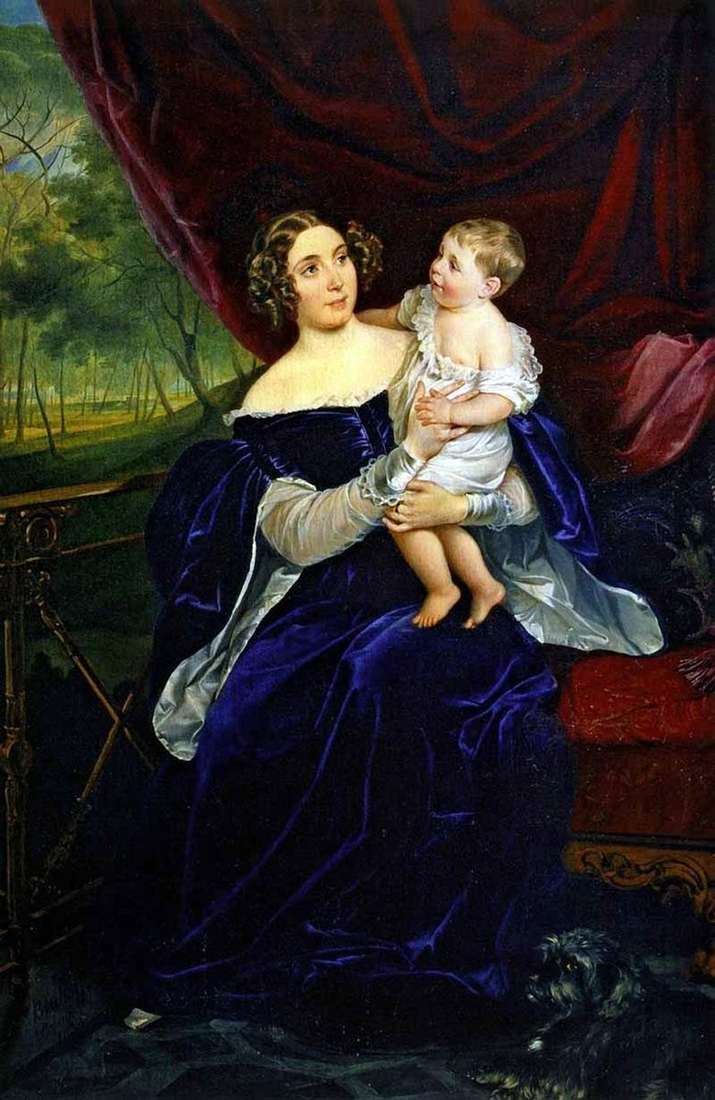
Olga Ivanovna Orlova-Davydova was the daughter of Prince Ivan Ivanovich Baryatinsky, one of the most influential and wealthy people in Russia – a secret adviser, chamberlain, ceremonial master of the court of Paul I. In 1832, Olga Ivanovna married Vladimir Petrovich Davydov, the grandson of Count Vladimir Grigoryevich Orlov, of the five famous brothers Orlovs – associates of Catherine II. The Orlov-Davydovs often traveled throughout Europe for a long time. Had been in Italy, England, patronizing artists and acquiring works of art. They were friends with K. Bryullov, who in 1834 in Rome painted a portrait of 20-year-old Olga Ivanovna with her daughter Natalia, two years later the artist, at the invitation of the Count, stayed for several months in Orlovy-Davydov’s estate “Otrada”.
From the writings of Vladimir Petrovich Davydov known “Travel notes, which he led during his stay in the Ionian Islands, Greece, Asia Minor and Turkey in 1835, in 2 parts., Published in 1839 in St. Petersburg. the graph was accompanied by artists KP Briullov, NE Efimov and Prussian antiquary Kramer. It is difficult to judge the merits of this work Bryullov, which came down to us in a distorted form. He was subjected in the XIX century to a barbarous operation that completely changed the artist’s original intention. vertically canvas and left only his right half, which is represented by gr.
Orlova-Davydova with a little daughter frolicking on her hands. Hence the incompleteness of the compositional solution and the lack of effectiveness, which were the most attractive aspects of all previous large works by Briullov. Unusual became the portrait format, too elongated in length, creating an unnatural relationship of figures with space. His composition became dull and lost its air environment. The feeling of narrowness, airlessness and static nature of the scene was made to relate Orlova-Davydova’s portrait to the number of unsuccessful works of the master.
The original composition of the portrait was different. Representation of the true nature of the work Briullov gives gouache NE Yefimova, made almost simultaneously with the portrait of Orlova-Davydova. In it Efimov painted an artist writing a large portrait of a young woman posing in front of him with a child in her arms in a spacious, sunlit room. It is easy to learn in the figure of the artist – KP Bryullov, and in his model – rp. OI Orlov-Davydov. The accuracy of the image did not change NK Efimov. He showed the countess in the same dress and pose as in Briullov’s Portrait, but with a different hairstyle.
In Efimov’s gouache, Orlova-Davydova’s hair was picked up high on the crown of her head in a knot that is not in Bryullov’s image. When studying the portrait of the Tretyakov Gallery it is easy to detect, even with the naked eye, an old record, which falls exactly at the place where there should be an absent detail of the Countess’s hair. But the most significant difference is that there is no rider in the portrait of Bryullov, which is shown in the gouache of Efimov. Riding on the bay horse, he drives up to the open doors of the balcony, where the countess with a small daughter is sitting. His face is obscured by the palette of the artist standing on the stepladder in front of his creation. Whom, as not the husband of the countess, we can assume in the figure of the horsemen. Literary data indicate the existence of an unknown image of gr. Vladimir Petrovich Orlov-Davydov, carved from a large portrait. In the portrait of OI Orlova-Davydova, who came to the Tretyakov Gallery in 1921. with a duplicated canvas, there are no edges. this fact says that the canvas was cut off by painting.
The reliability of the scene depicted in the gouache Efimov is confirmed by OI Orlova-Davydova herself. In one of her diary entries, referring to January, 1835, it is reported: “Efimov wrote a gouache, depicting the interior of Vladimir’s office with a portrait of Bryullov.” “Reconstruction” of Orlova-Davydova’s portrait allows us to speak about one more inspired work by Bryullov. As in the previous portraits, Bryullov included in his composition various components of large canvases: man, landscape, architecture. The group portrait was revealed as a genre family scene. Being circumcised, the portrait of Orlova-Davydova lost its inherent plot. The Countess was in the position of an actor who had lost a partner, with whom, during the course of the action, she was to conduct a dialogue.
 Portrait d’O. I. Orlova-Davydova avec sa fille – Karl Bryullov
Portrait d’O. I. Orlova-Davydova avec sa fille – Karl Bryullov Retrato de O. I. Orlova-Davydova con su hija – Karl Bryullov
Retrato de O. I. Orlova-Davydova con su hija – Karl Bryullov Portrait of Vel. Book. Elena Pavlovna with her daughter by Karl Bryullov
Portrait of Vel. Book. Elena Pavlovna with her daughter by Karl Bryullov Portrait of MA Beck with her daughter by Karl Bryullov
Portrait of MA Beck with her daughter by Karl Bryullov Portrait of MI Buteneva with her daughter by Karl Bryullov
Portrait of MI Buteneva with her daughter by Karl Bryullov Portrait of Captain B. Kostetskiy by Karl Bryullov
Portrait of Captain B. Kostetskiy by Karl Bryullov Portrait of Countess Samoilova by Karl Bryullov
Portrait of Countess Samoilova by Karl Bryullov Portrait of Yu. P. Samoylova with Giovannina Pacini and Arapchonka by Karl Bryullov
Portrait of Yu. P. Samoylova with Giovannina Pacini and Arapchonka by Karl Bryullov